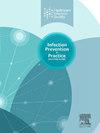坦桑尼亚姆万扎地区医院第三代耐头孢菌素革兰氏阴性菌污染医院表面:迫切需要加强感染预防和控制
IF 1.9
Q3 INFECTIOUS DISEASES
引用次数: 0
摘要
医院表面是耐多药病原体的重要宿主,包括第三代耐头孢菌素革兰氏阴性菌(3GC-R-GNB),对医疗保健相关感染(HCAIs)有重要影响。这一挑战在低收入和中等收入国家尤为突出,这些国家的资源限制了有效的感染预防和控制措施。本研究在坦桑尼亚姆万扎选定的地区医院(DHs)筛选医院表面3GC-R-GNB。方法本研究于2023年6 - 7月在医院进行。对门把手、洗手池、病人床和病房地板进行了采样。在添加头孢噻肟(2 μg/ml)的MacConkey琼脂上分离3GC-R-GNB。采用Vitek质谱MALDI-TOF法进行细菌鉴定,Kirby-Bauer法进行药敏试验。采用多重PCR法检测广谱β -内酰胺酶(ESBL)基因(blaCTX-M、blaSHV和blaTEM)。结果共采集医院表面拭子892份,3GC-R-GNB阳性243份(27.2%)。在243份阳性样品中,55份样品呈现多微生物生长,共分离出300株细菌。最常见的菌种为鲍曼不动杆菌(26.0%,78/300),其次为肺炎克雷伯菌(11.0%,33/300)、大肠杆菌(8.0%,24/300)和灰木乳杆菌(7.0%,21/300)。对所选分离株(n=243)的多重PCR结果显示,3GC-R-GNB中分别含有99.6%(242/243)、93.4%(227/243)和2.9%(7/243)的blaCTX-M、blaSHV编码ESBLs基因。结论本研究揭示了高耐药革兰氏阴性菌在医院表面的大量扩散,表明有必要防止这种污染的扩散,并采取有针对性的医院卫生措施来保护患者。本文章由计算机程序翻译,如有差异,请以英文原文为准。
Contamination of hospital surfaces by third-generation cephalosporin-resistant gram-negative bacteria in district hospitals in Mwanza, Tanzania: Urgent need for enhanced infection prevention and control
Background
Hospital surfaces are critical reservoirs of multidrug-resistant pathogens, including third-generation cephalosporin-resistant Gram-negative bacteria (3GC-R-GNB), significantly contributing to healthcare-associated infections (HCAIs). This challenge is pronounced in low- and middle-income countries, where resource constraints limit effective infection prevention and control (IPC) measures. This study screened hospital surfaces for 3GC-R-GNB in selected District Hospitals (DHs) in Mwanza, Tanzania.
Methods
This cross-sectional hospital-based study was conducted between June and July, 2023. Door handles, hand-washing sinks, patients' beds, and ward floors were sampled. Isolation of 3GC-R-GNB was done on MacConkey agar supplemented with cefotaxime (2 μg/ml). Bacterial identification was done by MALDI-TOF on Vitek MS while antimicrobial susceptibility testing was done by the Kirby-Bauer method. A multiplex PCR assay was applied for the detection of extended-spectrum beta-lactamase (ESBL) genes (blaCTX-M, blaSHV, and blaTEM).
Results
A total of 892 swabs were collected from hospital surfaces, of which 243 (27.2%) were 3GC-R-GNB positive. From the 243 positive samples, 55 samples exhibited polymicrobial growth making a total of 300 bacterial isolates. The most prevalent species was Acinetobacter baumannii (26.0%, 78/300), followed by Klebsiella pneumoniae (11.0%, 33/300), Escherichia coli (8.0%, 24/300), and Leclercia adecarboxylata (7.0%, 21/300). Multiplex PCR of selected isolates (n=243) revealed that 99.6% (242/243), 93.4% (227/243), and 2.9% (7/243) 3GC-R-GNB harbored blaTEM, blaCTX-M, and blaSHV genes encoding ESBLs, respectively.
Conclusion
This study reveals substantial dispersion of highly resistant Gram-negative bacteria to hospital surfaces, showing the need to prevent dispersion of such contamination and targeted hospital hygiene measures to protect patients.
求助全文
通过发布文献求助,成功后即可免费获取论文全文。
去求助
来源期刊

Infection Prevention in Practice
Medicine-Public Health, Environmental and Occupational Health
CiteScore
4.80
自引率
0.00%
发文量
58
审稿时长
61 days
 求助内容:
求助内容: 应助结果提醒方式:
应助结果提醒方式:


